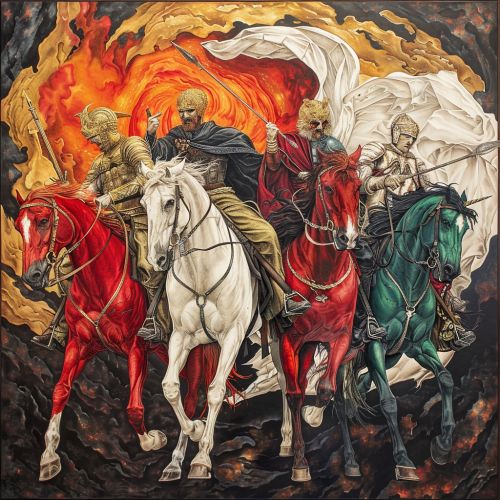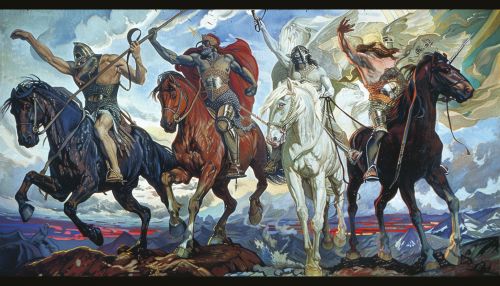The Four Horsemen of the Apocalypse
The Four Horsemen of the Apocalypse
The Four Horsemen of the Apocalypse are symbolic figures described in the Christian Book of Revelation (Revelation 6:1-8). They are often interpreted as harbingers of the Last Judgment and are typically depicted as riding horses of different colors, each representing a different aspect of the apocalypse: conquest, war, famine, and death. This article delves into the origins, interpretations, and cultural significance of these figures.


Origins and Biblical Description
The concept of the Four Horsemen originates from the New Testament of the Christian Bible, specifically in the Book of Revelation, which is traditionally attributed to John of Patmos. The relevant passage is found in Revelation 6:1-8, where the Lamb of God opens the first four of the seven seals, each unleashing a horseman upon the world.
The First Horseman
The first horseman rides a white horse and is often referred to as "Conquest" or "Pestilence." The rider carries a bow and is given a crown, symbolizing victory and the spread of conquest or disease. Interpretations vary, with some viewing this figure as a representation of Christ or the Antichrist, while others see it as a symbol of imperialism or infectious disease.
The Second Horseman
The second horseman rides a red horse and is commonly associated with war. The rider wields a large sword and is given the power to take peace from the earth, leading people to kill one another. This horseman is often interpreted as a symbol of civil strife, conflict, and bloodshed.
The Third Horseman
The third horseman rides a black horse and is typically associated with famine. The rider holds a pair of scales, symbolizing the scarcity of food and the resulting economic disparity. The passage mentions exorbitant prices for basic foodstuffs, indicating a time of great scarcity and hardship.
The Fourth Horseman
The fourth horseman rides a pale horse, and his name is Death. Hades follows closely behind him. This rider is given authority over a quarter of the earth, to kill with sword, famine, plague, and by the wild beasts of the earth. This figure is often seen as the culmination of the previous three horsemen, representing widespread death and destruction.
Interpretations and Symbolism
The Four Horsemen have been interpreted in various ways throughout history, reflecting the concerns and anxieties of different eras. Early Christian writers often saw them as literal predictions of future events, while later interpretations have viewed them as allegorical representations of societal and natural forces.
Historical Context
In the context of the Roman Empire, the horsemen were seen as symbols of the empire's decline and the chaos that followed. The white horseman was sometimes interpreted as representing the Roman emperors or military leaders, while the red horseman symbolized the internal conflicts and civil wars that plagued the empire. The black horseman was seen as a representation of the famines that often accompanied war, and the pale horseman as the inevitable result of these calamities.
Modern Interpretations
In modern times, the Four Horsemen have been interpreted in various ways, reflecting contemporary concerns. Some see them as symbols of global issues such as war, disease, economic disparity, and environmental destruction. Others interpret them as psychological archetypes, representing different aspects of the human condition.
Cultural Impact
The Four Horsemen of the Apocalypse have had a significant impact on art, literature, and popular culture. They have been depicted in numerous paintings, sculptures, and other works of art, often serving as powerful symbols of destruction and renewal.
Art
Artists such as Albrecht Dürer and Viktor Vasnetsov have created iconic depictions of the Four Horsemen, each bringing their unique interpretation to the subject. Dürer's woodcut, created in 1498, is one of the most famous representations, capturing the terror and chaos associated with the horsemen.
Literature
The Four Horsemen have appeared in various literary works, from John Milton's "Paradise Lost" to Terry Pratchett and Neil Gaiman's "Good Omens." In these works, the horsemen are often used to explore themes of apocalypse, morality, and human nature.
Popular Culture
In popular culture, the Four Horsemen have appeared in films, television shows, video games, and music. They are often used as symbols of impending doom or as characters in apocalyptic narratives. For example, the horsemen feature prominently in the video game series "Darksiders" and the television series "Supernatural."
Theological Perspectives
The Four Horsemen are a subject of considerable theological debate. Different Christian denominations and theologians have varying interpretations of their significance and meaning.
Preterist View
The preterist view interprets the horsemen as symbols of events that occurred in the first century, particularly the fall of Jerusalem and the subsequent Roman-Jewish wars. According to this perspective, the horsemen represent the historical realities faced by early Christians.
Futurist View
The futurist view sees the horsemen as predictions of future events that will occur during the end times. This interpretation is common among evangelical Christians and is often associated with dispensationalism.
Idealist View
The idealist view interprets the horsemen as symbolic representations of ongoing spiritual and moral struggles. According to this perspective, the horsemen are not tied to specific historical events but represent timeless truths about the human condition.
Psychological and Archetypal Interpretations
Some scholars and psychologists have interpreted the Four Horsemen as archetypal symbols representing different aspects of the human psyche. This perspective draws on the work of Carl Jung and other depth psychologists.
Jungian Analysis
In Jungian analysis, the horsemen can be seen as archetypes representing different aspects of the collective unconscious. The white horseman might symbolize the shadow or the repressed aspects of the self, while the red horseman represents the aggressive and destructive impulses. The black horseman could be seen as a symbol of deprivation and scarcity, and the pale horseman as the inevitability of death.
Cultural Archetypes
The horsemen also function as cultural archetypes, representing universal themes of conflict, scarcity, and mortality. They serve as powerful symbols in storytelling, allowing writers and artists to explore complex themes in a compelling and accessible way.
Conclusion
The Four Horsemen of the Apocalypse are rich and multifaceted symbols that have captured the human imagination for centuries. Whether viewed as literal predictions, allegorical representations, or psychological archetypes, they continue to resonate with people across different cultures and historical periods. Their enduring appeal lies in their ability to encapsulate fundamental aspects of the human experience, from the inevitability of conflict and scarcity to the ultimate reality of death.
